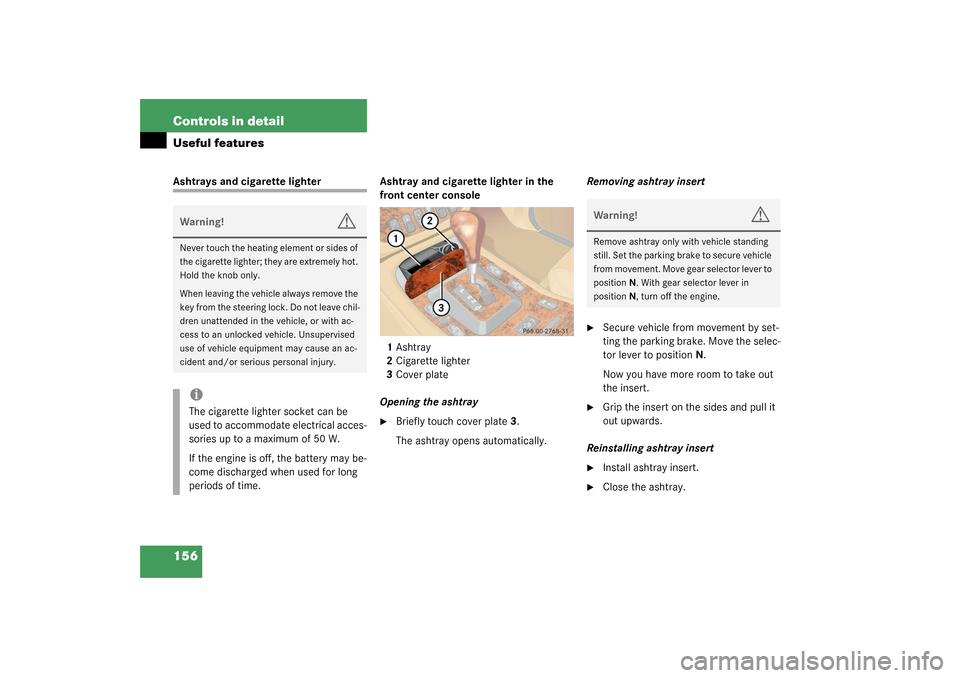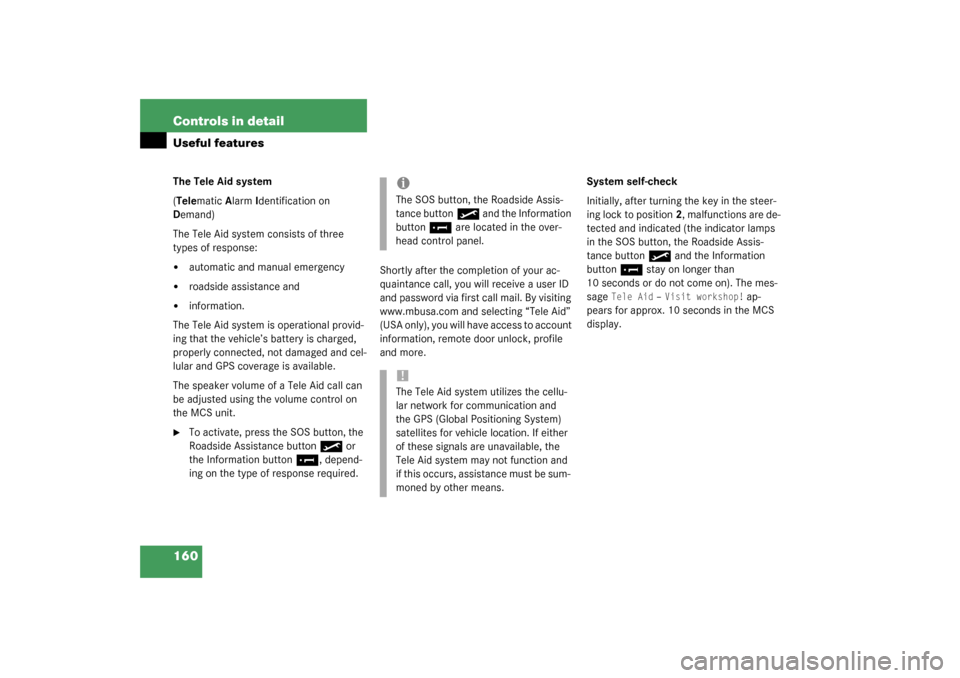Page 109 of 321
109 Controls in detail
Lighting
Cargo compartment lamp
1Switched off
2Switched on continuously
3Automatic controlSwitching off cargo compartment lamp
�
Slide the switch to position1.
The cargo compartment lamp is
switched off, even when the liftgate is
opened.
Switching on continuous cargo
compartment lamp
�
Slide the switch to position2.
The cargo compartment lamp is
switched on continuously.Automatic control
�
Slide the switch to position3.
The cargo compartment lamp is
switched on and off by opening or clos-
ing the liftgate.
iTo prevent the vehicle battery from be-
ing discharged, make sure that the
switch is not in position2 when leaving
the vehicle.
Page 130 of 321

130 Controls in detailAutomatic climate controlActivating
Moist air can fog up the windows. You can
dehumidify the air with the air condition-
ing.�
Press button
°
again.
The indicator lamp on the button
°
goes out.
The air conditioning system uses the refrig-
erant R134A. This refrigerant is free of
CFCs which are harmful to the ozone layer.
Residual heat and ventilation
With the engine switched off, it is possible
to continue to heat or ventilate the interior
for up to 30 minutes. This feature makes
use of the residual heat produced by the
engine.
Activating�
Turn the key in the steering lock to
position1.
�
Press button
°
(�page 125).
The indicator lamp on button
°
comes on.Deactivating
�
Press button
°
.
The indicator lamp on button
°
goes out.
!If the
°
button on the automatic cli-
mate control panel starts to blink, this
indicates that the air conditioning sys-
tem is losing refrigerant. The compres-
sor has turned itself off. The air
conditioning cannot be turned on
again.
Have the air conditioning system
checked at the nearest authorized
Mercedes-Benz Light Truck Center.
iHow long the system will provide heat-
ing depends on the coolant tempera-
ture and the temperature set in the
climate control. The blower will run at
lower speed regardless of the air vol-
ume control setting.
iThe residual heat is automatically
turned off:�
when the ignition is switched on
�
after about 30 minutes
�
if the coolant temperature is too
low
�
if the battery voltage drops
Page 131 of 321

131 Controls in detail
Automatic climate control
Rear window defroster
The rear window defroster uses a large
amount of power. To keep the battery
drain to a minimum, switch off the defrost-
er as soon as the rear window is clear. The
defroster is automatically deactivated af-
ter approximately 6 to 17 minutes of oper-
ation depending on the outside
temperature.
Activating�
Switch ignition on.
�
Press button
F
(�page 125).
The indicator lamp on the button lights
up.
Deactivating
�
Press button
F
again.
The indicator lamp on the button goes
out.Rear passenger compartment ventila-
tion and rear automatic climate control
Deactivating
For an improved cooling or heating output
in the front passenger compartment, you
can switch off the rear passenger compart-
ment ventilation.�
Press button
§
(�page 125).
The indicator lamp on the button lights
up.
The operation of the rear automatic cli-
mate control and the fresh air supply to
the rear compartment is shut off.
Activating
�
Press button
§
again.
The indicator lamp on the button goes
out.
The rear automatic climate control
switches to automatic mode and fresh
air enters the rear compartment.
Warning!
G
Any accumulation of snow and ice should be
removed from the rear window before driv-
ing. Visibility could otherwise be impaired,
endangering you and others.!If the rear window defroster switches
off too soon and the indicator lamp
starts blinking, this means that too
many electrical consumers are operat-
ing simultaneously and there is insuffi-
cient voltage in the battery. The system
responds automatically by deactivating
the rear window defroster.
As soon as the battery has sufficient
voltage, the rear window defroster au-
tomatically turns itself back on.
Page 136 of 321

136 Controls in detailPower windowsSynchronizing power windows
The side power windows must be resyn-
chronized�
after the battery has been disconnect-
ed
�
if the windows cannot be fully opened
or closed
�
Switch ignition on.
�
Press switch
j
until the window is
completely closed and hold down for
approximately 1 second. Repeat proce-
dure for each window.
Rear quarter windows*
The switches are on the upper part of the
center console.
1Left side
2Right side
To operate the power windows, turn key to
position2 (
�page 33) in the steering lock.Opening the windows
�
Press and hold the upper part of
switches1 or2.
The window will open.
Closing the windows
�
Press and hold the lower part of
switches1 or2.
The window will close.Warning!
G
When closing the windows, make sure that
there is no danger of anyone being harmed
by the closing procedure.
When leaving the vehicle, always remove the
key from the steering lock, and lock the ve-
hicle. Do not leave children unattended in
the vehicle, or with access to an unlocked
vehicle. Unsupervised use of vehicle equip-
ment may cause an accident and/or serious
personal injury.
Page 138 of 321
138 Controls in detailSliding/pop-up roof*Opening the roof automatically�
Briefly press the switch in direction2.
The roof will not open to the fully open
position.
To open the roof fully, press switch
again in direction2.Synchronizing the sliding / pop-up roof
The power sliding/pop-up roof must be re-
synchronized each time after the battery
has been disconnected, the slid-
ing/pop-up roof has been closed manually
or the sliding/pop-up roof does not open
smoothly or malfunctions (
�page 246).
iTo interrupt procedure, briefly move
switch in any direction.
!To avoid damaging the seals, do not
transport any objects with sharp edges
which can stick out of the slid-
ing/pop-up roof.
The sliding/pop-up roof can be opened
or closed manually should an electrical
malfunction occur (
�page 246).
Page 156 of 321

156 Controls in detailUseful featuresAshtrays and cigarette lighter Ashtray and cigarette lighter in the
front center console
1Ashtray
2Cigarette lighter
3Cover plate
Opening the ashtray
�
Briefly touch cover plate3.
The ashtray opens automatically.Removing ashtray insert
�
Secure vehicle from movement by set-
ting the parking brake. Move the selec-
tor lever to positionN.
Now you have more room to take out
the insert.
�
Grip the insert on the sides and pull it
out upwards.
Reinstalling ashtray insert
�
Install ashtray insert.
�
Close the ashtray.
Warning!
G
Never touch the heating element or sides of
the cigarette lighter; they are extremely hot.
Hold the knob only.
When leaving the vehicle always remove the
key from the steering lock. Do not leave chil-
dren unattended in the vehicle, or with ac-
cess to an unlocked vehicle. Unsupervised
use of vehicle equipment may cause an ac-
cident and/or serious personal injury.iThe cigarette lighter socket can be
used to accommodate electrical acces-
sories up to a maximum of 50 W.
If the engine is off, the battery may be-
come discharged when used for long
periods of time.
Warning!
G
Remove ashtray only with vehicle standing
still. Set the parking brake to secure vehicle
from movement. Move gear selector lever to
positionN. With gear selector lever in
positionN, turn off the engine.
Page 158 of 321

158 Controls in detailUseful featuresElectrical outletElectrical outletOne outlet is located in the front passen-
ger footwell and another on the right-hand
side of the luggage compartment.�
Flip up cover and insert electrical plug
(cigarette lighter type).
Telephone*
Radio transmitters, such as a portable tele-
phone or a citizens band unit, should only
be used inside the vehicle if they are con-
nected to an antenna that is installed on
the outside of the vehicle.
The external antenna must be approved by
Mercedes-Benz. Please contact an autho-
rized Mercedes-Benz Light Truck Center
for information on the installation of an ap-
proved external antenna. Refer to the radio
transmitter operation instructions regard-
ing use of an external antenna.
iThe outlets function even if the key is
not in the ignition.
The electrical outlet can be used to ac-
commodate electrical consumers (e.g.
air pump, auxiliary lamps) up to a max-
imum of 180 W.
If the engine is off, the battery may be-
come discharged if used for long peri-
ods of time.
Warning!
G
Never operate radio transmitters equipped
with a built-in or attached antenna (i.e. with-
out being connected to an external antenna)
from inside the vehicle while the engine is
running. Doing so could lead to a malfunc-
tion of the vehicle’s electronic system, pos-
sibly resulting in an accident and/or serious
personal injury.
Page 160 of 321

160 Controls in detailUseful featuresThe Tele Aid system
(Telematic Alarm Identification on
Demand)
The Tele Aid system consists of three
types of response:�
automatic and manual emergency
�
roadside assistance and
�
information.
The Tele Aid system is operational provid-
ing that the vehicle’s battery is charged,
properly connected, not damaged and cel-
lular and GPS coverage is available.
The speaker volume of a Tele Aid call can
be adjusted using the volume control on
the MCS unit.
�
To activate, press the SOS button, the
Roadside Assistance button
•
or
the Information button
¡
, depend-
ing on the type of response required.Shortly after the completion of your ac-
quaintance call, you will receive a user ID
and password via first call mail. By visiting
www.mbusa.com and selecting “Tele Aid”
( U S A o n l y ) , y o u w i l l h a v e a c c e s s t o a c c o u n t
information, remote door unlock, profile
and more.System self-check
Initially, after turning the key in the steer-
ing lock to position2, malfunctions are de-
tected and indicated (the indicator lamps
in the SOS button, the Roadside Assis-
tance button
•
and the Information
button
¡
stay on longer than
10 seconds or do not come on). The mes-
sage
Tele Aid
–Visit workshop!
ap-
pears for approx. 10 seconds in the MCS
display.
iThe SOS button, the Roadside Assis-
tance button
•
and the Information
button
¡
are located in the over-
head control panel.
!The Tele Aid system utilizes the cellu-
lar network for communication and
the GPS (Global Positioning System)
satellites for vehicle location. If either
of these signals are unavailable, the
Tele Aid system may not function and
if this occurs, assistance must be sum-
moned by other means.